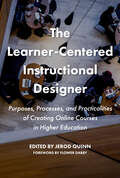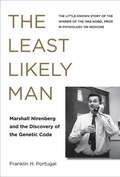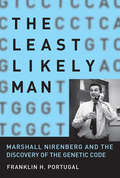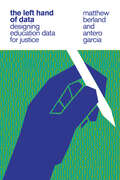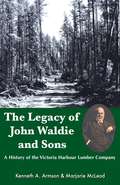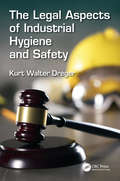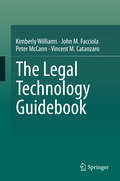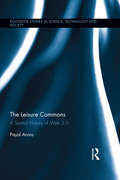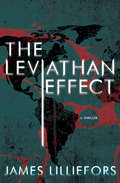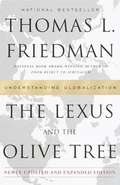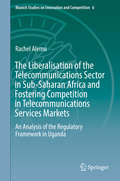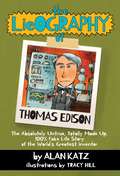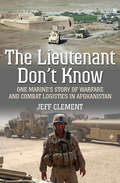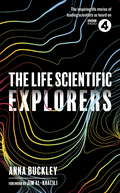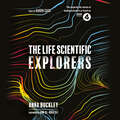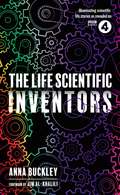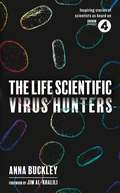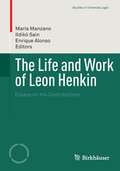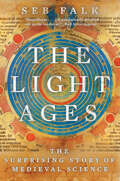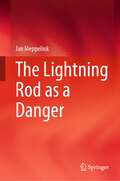- Table View
- List View
The Learner-Centered Instructional Designer: Purposes, Processes, and Practicalities of Creating Online Courses in Higher Education
by Flower Darby Jerod Quinn“What does a new instructional designer need to know to find her or his feet when working with faculty to create online classes?” This is a practical handbook for established and aspiring instructional designers in higher education, readers who may also be identified by such professional titles as educational developer, instructional technologist, or online learning specialist. Jerod Quinn, together with a team of experienced instructional designers who have worked extensively with a wide range of faculty on a multiplicity of online courses across all types of institutions, offer key guiding principles, insights and advice on how to develop productive and collegial partnerships with faculty to deliver courses that engage students and promote enduring learning.Designing and developing online classes for higher education takes a combination of pedagogical knowledge, the ability to build trust with faculty, familiarity with frameworks on how people learn, understanding of accessibility and inclusion, and technical skills to leverage a learning management system into an educational experience. Coming from diverse backgrounds, few instructional designers enter academia well versed in all of these aspects of creating online classes. This book provides the foundation on which instructional designers can build their careers. The guiding principle that animates this book is that the student experience and successful learning outcomes are paramount, and governs discussion of course design, pedagogy, the use of multimedia and technological advances, as well as the use of different forms of interactive exercises and group assignments. The succinct, informally written chapters offer ideas and means to apply theory to the daily work of instructional design and cover the four key components that drive this work in higher education: ·Defining the scope and main design approaches of our work·Building trust with the faculty we work with·Applying frameworks of how people learn·Mastering common online instructional practices.
The Least Likely Man: Marshall Nirenberg and the Discovery of the Genetic Code
by Franklin H. PortugalThe genetic code is the Rosetta Stone by which we interpret the 3.3 billion letters of human DNA, the alphabet of life, and the discovery of the code has had an immeasurable impact on science and society. In 1968, Marshall Nirenberg, an unassuming government scientist working at the National Institutes of Health, shared the Nobel Prize for cracking the genetic code. He was the least likely man to make such an earth-shaking discovery, and yet he had gotten there before such members of the scientific elite as James Watson and Francis Crick. How did Nirenberg do it, and why is he so little known? In The Least Likely Man, Franklin Portugal tells the fascinating life story of a famous scientist that most of us have never heard of.<P><P> Nirenberg did not have a particularly brilliant undergraduate or graduate career. After being hired as a researcher at the NIH, he quietly explored how cells make proteins. Meanwhile, Watson, Crick, and eighteen other leading scientists had formed the "RNA Tie Club" (named after the distinctive ties they wore, each decorated with one of twenty amino acid designs), intending to claim credit for the discovery of the genetic code before they had even worked out the details. They were surprised, and displeased, when Nirenberg announced his preliminary findings of a genetic code at an international meeting in Moscow in 1961.<P> Drawing on Nirenberg's "lab diaries," Portugal offers an engaging and accessible account of Nirenberg's experimental approach, describes counterclaims by Crick, Watson, and Sidney Brenner, and traces Nirenberg's later switch to an entirely new, even more challenging field. Having won the Nobel for his work on the genetic code, Nirenberg moved on to the next frontier of biological research: how the brain works.
The Least Likely Man: Marshall Nirenberg and the Discovery of the Genetic Code (The\mit Press Ser.)
by Franklin H. PortugalHow unassuming government researcher Marshall Nirenberg beat James Watson, Francis Crick, and other world-famous scientists in the race to discover the genetic code.The genetic code is the Rosetta Stone by which we interpret the 3.3 billion letters of human DNA, the alphabet of life, and the discovery of the code has had an immeasurable impact on science and society. In 1968, Marshall Nirenberg, an unassuming government scientist working at the National Institutes of Health, shared the Nobel Prize for cracking the genetic code. He was the least likely man to make such an earth-shaking discovery, and yet he had gotten there before such members of the scientific elite as James Watson and Francis Crick. How did Nirenberg do it, and why is he so little known? In The Least Likely Man, Franklin Portugal tells the fascinating life story of a famous scientist that most of us have never heard of.Nirenberg did not have a particularly brilliant undergraduate or graduate career. After being hired as a researcher at the NIH, he quietly explored how cells make proteins. Meanwhile, Watson, Crick, and eighteen other leading scientists had formed the “RNA Tie Club” (named after the distinctive ties they wore, each decorated with one of twenty amino acid designs), intending to claim credit for the discovery of the genetic code before they had even worked out the details. They were surprised, and displeased, when Nirenberg announced his preliminary findings of a genetic code at an international meeting in Moscow in 1961. Drawing on Nirenberg's “lab diaries,” Portugal offers an engaging and accessible account of Nirenberg's experimental approach, describes counterclaims by Crick, Watson, and Sidney Brenner, and traces Nirenberg's later switch to an entirely new, even more challenging field. Having won the Nobel for his work on the genetic code, Nirenberg moved on to the next frontier of biological research: how the brain works.
The Left Hand of Data: Designing Education Data for Justice
by Antero Garcia Matthew BerlandA speculative framework that imagines how we can use education data to promote play, creativity, and social justice over normativity and conformity.Educational analytics tend toward aggregation, asking what a &“normative&” learner does. In The Left Hand of Data, educational researchers Matthew Berland and Antero Garcia start from a different assumption—that outliers are, and must be treated as, valued individuals. Berland and Garcia argue that the aim of analytics should not be about enforcing and entrenching norms but about using data science to break new ground and enable play and creativity. From this speculative vantage point, they ask how we can go about living alongside data in a better way, in a more just way, while also building on the existing technologies and our knowledge of the present.The Left Hand of Data explores the many ways in which we use data to shape the possible futures of young people—in schools, in informal learning environments, in colleges, in libraries, and with educational games. It considers the processes by which students are sorted, labeled, categorized, and intervened upon using the bevy of data extracted and collected from individuals and groups, anonymously or identifiably. When, how, and with what biases are these data collected and utilized? What decisions must educational researchers make around data in an era of high-stakes assessment, surveillance, and rising inequities tied to race, class, gender, and other intersectional factors? How are these complex considerations around data changing in the rapidly evolving world of machine learning, AI, and emerging fields of educational data science? The surprising answers the authors discover in their research make clear that we do not need to wait for a hazy tomorrow to do better today.
The Legacy of John Waldie and Sons: A History of the Victoria Harbour Lumber Company
by Kenneth A. Armson Marjorie McleodAt the time of his death in 1907, John Waldie, founder of the Victoria Harbour Lumber Company, was identified as "the second largest lumber operator in Canada." A young Scottish immigrant who came to Wellington Square (now Burlington, Ontario) in 1842, he rose to prominence as a wealthy merchant and ship owner. In 1885 he entered the lumber business. Active in local and federal politics, and a friend of Sir Wilfrid Laurier, he invested capital in mills, people and forests.Local history and genealogical connections are part of the Waldie story, headquartered at Victoria Harbour in Simcoe County. Documentation of the forest that the company logged, their nature, amount and sizes of logs harvested with the descriptions of the forests as they are now, throws new light and shatters some of the current myths.This little-known story provides insights into days of rampant entrepreneurialism, the world of the lumber barons and the overall impact on our Ontario forests.
The Legal Aspects of Industrial Hygiene and Safety (Sustainable Improvements in Environment Safety and Health)
by Kurt W. DregerThe Legal Aspects of Industrial Hygiene and Safety explores various legal issues that are often encountered by Industrial Hygiene and Safety managers during their careers. A description is presented of the various legal concepts and processes that often arise in the IH/S practice, including tort, contract, and administrative law. The goal is to provide IH/S managers with sufficient knowledge to be able to incorporate legal risk analysis into everyday decision-making and policy development. This book will explore the legal issues that arise in IH/S practice and will be helpful to new IH/S managers as they progress in their careers. FEATURES Explores various legal issues that are often encountered by Industrial Hygiene and Safety managers during their careers Provides insight into the legal issues and processes to IH/S managers that are traditionally only available to attorneys Improves the IH/S managers' ability to communicate complex IH/S issues to in-house counsel Presents tools and knowledge to IH/S managers so they can better consider the legal risks of the decisions they make Covers various legal concepts and processes that can arise in the IH/S practice, including tort, contract, and administrative law
The Legal Challenges of the Fourth Industrial Revolution: The European Union's Digital Strategy (Law, Governance and Technology Series #57)
by Chen Chen Dário Moura Vicente Sofia de Vasconcelos CasimiroThis book explores the concept of a fourth industrial revolution as an expression of the current technological, economic, and social changes sparked by the growing interconnectivity and intelligent automation that have emerged in the 21st century. It seeks to identify and explain the legal challenges posed by this phenomenon in four main areas: content, economy, security, and people.Part I, Content, considers e.g. the problems posed by new uses of protected works in the digital environment, and the new rules on liability for intermediary services contained in the Digital Services Act.Part II, Economy, is particularly concerned with the regulation of Big Tech in the EU’s Digital Markets Act, ecommerce and EU consumers’ rights, the taxation of online platforms, and digital advertising.Part III, Security, addresses the European Union Strategy for Cybersecurity, the use of biometric data systems and facial recognition technologies for law enforcement purposes, and the security implications of the Proposal for an EU Regulation on Artificial Intelligence, as well as the challenges entailed by the European Union’s positioning itself as a major cyber defence actor.Part IV, People, discusses the Data Protection Litigation System under the GDPR, the right to disconnect from work, the proposed EU Catalogue of Fundamental Digital Rights, the countering of terrorist propaganda online through the TERREG and the DSA, and AI and Fundamental Rights.
The Legal Dimensions of Oil and Gas in Iraq
by Rex J. ZedalisThis volume presents the first and only comprehensive examination of the legal issues surrounding international debt recovery on claims against Iraqi oil and gas. In addition to presenting a snapshot view of Iraq's outstanding debt obligations and an analysis of the significance of the theory of odious debt in the context of the Iraqi situation, the list of legal issues examined includes relevant provisions of the Iraqi Constitution of 2005, controlling Security Council resolutions, pertinent articles of the KRG oil and gas law (No. 22) of 2007 and the many nuanced and technical questions raised thereby, legal pronouncements aimed at protecting Iraqi oil and gas and those adopted in selected other nations, and general problems associated with recognition and enforcement of awards or judgments that may involve such oil and gas or revenues from the sale thereof. Also discussed are the lessons learned by the handling of the Iraq debt experience and the transferability of those lessons to future situations in which resource-rich nations may have outstanding financial obligations to other members of the world community or their nationals.
The Legal Technology Guidebook
by Kimberly Williams John M. Facciola Peter Mccann Vincent M. CatanzaroThis book explores the transformational impact of new technological developments on legal practice. More specifically, it addresses knowledge management, communication, and e-discovery related technologies, and helps readers develop the project management and data analysis skills needed to effectively navigate the current, and future, landscapes. It studies the impact of current trends on business practices, as well as the ethical, procedural, and evidentiary concerns involved. Introducing novel interactive technologies as well as traditional content, the book reflects expertise from across the legal industry, including practitioners, the bench, academia, and legal technology consultants. All of the contributing authors currently teach aspiring lawyers and/or paralegals and have identified a gap in the available instructional material. Rapid technology advances have radically changed the way we all live and work, and the legal profession is by no means exempt from the impact of these changes. In order to better assist their clients, and to better compete on the legal market, it is imperative for lawyers to understand the ethical, functional, and business consequences of new technologies on their respective practices. This book provides the necessary content by including legal technology texts, information about novel pedagogical technologies, helpful tools for managing legal technologies and IT staff, statistical methods, tips and checklists.
The Leisure Commons: A Spatial History of Web 2.0 (Routledge Studies in Science, Technology and Society #27)
by Payal AroraThere is much excitement about Web 2.0 as an unprecedented, novel, community-building space for experiencing, producing, and consuming leisure, particularly through social network sites. What is needed is a perspective that is invested in neither a utopian or dystopian posture but sees historical continuity to this cyberleisure geography. This book investigates the digital public sphere by drawing parallels to another leisure space that shares its rhetoric of being open, democratic, and free for all: the urban park. It makes the case that the history and politics of public parks as an urban commons provides fresh insight into contemporary debates on corporatization, democratization and privatization of the digital commons. This book takes the reader on a metaphorical journey through multiple forms of public parks such as Protest Parks, Walled Gardens, Corporate Parks, Fantasy Parks, and Global Parks, addressing issues such as virtual activism, online privacy/surveillance, digital labor, branding, and globalization of digital networks. Ranging from the 19th century British factory garden to Tokyo Disneyland, this book offers numerous spatial metaphors to bring to life aspects of new media spaces. Readers looking for an interdisciplinary, historical and spatial approach to staid Web 2.0 discourses will undoubtedly benefit from this text.
The Leviathan Effect: A Thriller (A\mallory Brothers Thriller Ser.)
by James LillieforsHomeland Security Secretary Catherine Blaine receives a frightening communication from a hacker identified only by the pseudonym "Janus": three recent natural disasters around the world were correctly predicted--in fact, they were manufactured, not natural at all. And, says the email, unless she does exactly as Janus instructs, more disasters are coming--and they will destroy the United States. Unaware of the crisis in Washington, investigative journalist Jon Mallory stumbles on a list of seven prominent scientists who have been murdered in recent months. When the person who had given him the list goes missing herself, Jon realizes he has unwittingly become part of a deadly chain of events. He contacts his brother, ex-CIA agent Charles, looking for help. Meanwhile, Catherine Blaine has also come to Charles for help to track down the hacker Janus and learn what frightening science is threatening the world.
The Lexus and the Olive Tree: Understanding Globalization
by Thomas L. FriedmanFrom one of our most perceptive commentators and winner of the National Book Award, a comprehensive look at the new world of globalization, the international system that, more than anything else, is shaping world affairs today. As the Foreign Affairs columnist for The New York Times, Thomas L. Friedman has traveled the globe, interviewing people from all walks of contemporary life: Brazilian peasants in the Amazon rain forest, new entrepreneurs in Indonesia, Islamic students in Teheran, and the financial wizards on Wall Street and in Silicon Valley. Now Friedman has drawn on his years on the road to produce an engrossing and original look at globalization. Globalization, he argues, is not just a phenomenon and not just a passing trend. It is the international system that replaced the Cold War system; the new, well-greased, interconnected system: Globalization is the integration of capital, technology, and information across national borders, in a way that is creating a single global market and, to some degree, a global village. Simply put, one can't possibly understand the morning news or one's own investments without some grasp of the system. Just one example: During the Cold War, we reached for the hot line between the White House and the Kremlin--a symbol that we were all divided but at least the two superpowers were in charge. In the era of globalization, we reach for the Internet--a symbol that we are all connected but nobody is totally in charge. With vivid stories and a set of original terms and concepts, Friedman offers readers remarkable access to his unique understanding of this new world order, and shows us how to see this new system. He dramatizes the conflict of "the Lexus and the olive tree"--the tension between the globalization system and ancient forces of culture, geography, tradition, and community. He also details the powerful backlash that globalization produces among those who feel brutalized by it, and he spells out what we all need to do to keep the system in balance. Finding the proper balance between the Lexus and the olive tree is the great drama of he globalization era, and the ultimate theme of Friedman's challenging, provocative book--essential reading for all who care about how the world really works.
The Liberalisation of the Telecommunications Sector in Sub-Saharan Africa and Fostering Competition in Telecommunications Services Markets
by Rachel AlemuThis study investigates whether the existing regulatory framework governing the telecommunications sector in countries in Sub-Saharan Africa effectively deals with emerging competition-related concerns in the liberalised sector. Using Uganda as a case study, it analyses the relevant provisions of the law governing competition in the telecommunications sector, and presents three key findings: Firstly, while there is comprehensive legislation on interconnection and spectrum management, inefficient enforcement of the legislation has perpetuated concerns surrounding spectrum scarcity and interconnection. Secondly, the legislative framework governing anti-competitive behaviour, though in line with the established principles of competition law, is not sufficient. Specifically, the framework is not equipped to govern the conduct of multinational telecommunications groups that have a strong presence in the telecommunications sector. Major factors hampering efficient competition regulation include Uganda's sole reliance on sector-specific competition rules, restricted available remedies, and a regulator with limited experience of enforcing competition legislation. The weaknesses in the framework strongly suggest the need to adopt an economy-wide competition law. Lastly, wireless technology is the main means through which the population in Uganda accesses telecommunications services. Greater emphasis should be placed on regulating conduct in the wireless communications markets.
The Lieography of Thomas Edison: The Absolutely Untrue, Totally Made Up, 100% Fake Life Story of the World's Greatest Inventor (Lieographies Ser. #1)
by Alan KatzThomas Edison, world-class inventor. You might know that he devised the electric light bulb and the phonograph. But what about his development of train-controlling sticks? Or his airborne way to send pancakes to his Cousin Fran in Texas? You&’re about to be treated to the Lieographical aspects of Thomas Edison&’s life, in this funny, lighthearted, &“all that didn&’t happen&” take on the man whose inventions transformed our daily existence. The book ends with a short—but true—account of Edison&’s life—just enough to encourage kids to find out more on this important historical figure. But even if readers have already learned about Edison, the wacky stories in this tall-tales book will be even more enjoyable.
The Lieutenant Don't Know: One Marine's Story of Warfare and Combat Logistics in Afghanistan
by Jeffrey Clement“A unique insight into the war experience . . . a realistic picture of what it is like to serve in Afghanistan as a Marine combat logistician” (Small Wars Journal).When he joined the Marines, Jeff Clement was not a high-speed, top-secret recon guy. A logistician instead, he led combat convoys across treacherous terrain in southern Afghanistan through frequent enemy attacks in order to resupply US and British positions. As such, he and his vehicles were a constant target for the resistance, and each movement was a travail, often accompanied by thundering blasts as the insurgents paved their way with IEDs. Every step forward was fraught with danger, even as each objective had to be met. As a Marine Corps lieutenant, he deployed to Afghanistan twice and always found a learning curve, as men previously on the ground were more savvy, and the insurgents, there for the duration, were savvier still.The Lieutenant Don’t Know provides a refreshing look at the nitty-gritty of what our troops have been dealing with in Afghanistan—from the perspective of a young officer who was perfectly willing to learn and take responsibility for his units in a confusing war where combat was not merely on the “front,” but all around and looking over all their roads.“Finally, a readable, honest and gritty account of the dangerous, exhausting labor that keeps ‘The Green Machine’ going.” —Bing West, New York Times–bestselling author of One Million Steps“One of the best war memoirs I’ve ever read . . . a moving, inspiring work, that’s enjoyable as hell, as well.” —Stan R. Mitchell, author of Gravel Road
The Life Scientific: Explorers
by Anna BuckleyInspiring life stories from BBC Radio 4's hit series The Life Scientific'In showing non-scientists why science offers so many paths to discovery it has no equal' Gillian Reynolds, TelegraphBased on Jim Al-Khalili's ground-breaking interviews, The Life Scientific: Explorers takes science out of its box and introduces us to the men and women who make it happen.The explorers featured in this volume include: Michele Dougherty, the mathematician who persuaded the Cassini mission to Saturn to make a diversion; Richard Fortey on his love of trilobites; Monica Grady, Meteorite Lady; neurosurgeon Henry Marsh on slicing through our thoughts; the Director of the British Antarctic Survey, Jane Francis; Jocelyn Bell Burnell describing how she missed out on a Nobel Prize; Brian Cox on quantum mechanics; and Nobel Prize winner John Sulston on why he thought it would be a good idea to sequence the human genome.
The Life Scientific: Explorers
by Anna BuckleyInspiring life stories from BBC Radio 4's hit series The Life Scientific'In showing non-scientists why science offers so many paths to discovery it has no equal' Gillian Reynolds, TelegraphBased on Jim Al-Khalili's ground-breaking interviews, The Life Scientific: Explorers takes science out of its box and introduces us to the men and women who make it happen.The explorers featured in this volume include: Michele Dougherty, the mathematician who persuaded the Cassini mission to Saturn to make a diversion; Richard Fortey on his love of trilobites; Monica Grady, Meteorite Lady; neurosurgeon Henry Marsh on slicing through our thoughts; the Director of the British Antarctic Survey, Jane Francis; Jocelyn Bell Burnell describing how she missed out on a Nobel Prize; Brian Cox on quantum mechanics; and Nobel Prize winner John Sulston on why he thought it would be a good idea to sequence the human genome.
The Life Scientific: Explorers
by Anna BuckleyInspiring life stories from BBC Radio 4's hit series The Life Scientific'In showing non-scientists why science offers so many paths to discovery it has no equal' Gillian Reynolds, TelegraphBased on Jim Al-Khalili's ground-breaking interviews, The Life Scientific: Explorers takes science out of its box and introduces us to the men and women who make it happen.The explorers featured in this volume include: Michele Dougherty, the mathematician who persuaded the Cassini mission to Saturn to make a diversion; Richard Fortey on his love of trilobites; Monica Grady, Meteorite Lady; neurosurgeon Henry Marsh on slicing through our thoughts; the Director of the British Antarctic Survey, Jane Francis; Jocelyn Bell Burnell describing how she missed out on a Nobel Prize; Brian Cox on quantum mechanics; and Nobel Prize winner John Sulston on why he thought it would be a good idea to sequence the human genome.
The Life Scientific: Inventors
by Anna BuckleyWhat does it take to be an inventor? Judging by the ingenious individuals who have come into The Life Scientific studio in the last eight years, there is no simple answer. Mathematicians, electricians, molecular biologists and mechanics can all transform lives. Some think with their hands, others make things in their minds. Most have a vision of the future. All are driven by a passionate determination to solve problems.These intimate accounts, based on interviews recorded for the popular BBC Radio 4 programme The Life Scientific, chart the life journeys of scientists and engineers working in Britain today from childhood interests to innovation. Explaining what they did when and why, they make science seem straightforward and exciting, revealing moments of disappointment, creativity, frustration and joy. The result is an illuminating collection of biographical short stories that make scientists and the work they do accessible to us all.
The Life Scientific: Inventors
by Anna BuckleyWhat does it take to be an inventor?Judging by the ingenious individuals who have come into The Life Scientific studio in the last eight years, there is no simple answer. Mathematicians, electricians, molecular biologists and mechanics can all transform lives. Some think with their hands, others make things in their minds. Most have a vision of the future. All are driven by a passionate determination to solve problems.These intimate accounts, based on interviews recorded for the popular BBC Radio 4 programme The Life Scientific, chart the life journeys of scientists and engineers working in Britain today from childhood interests to innovation. Explaining what they did when and why, they make science seem straightforward and exciting, revealing moments of disappointment, creativity, frustration and joy. The result is an illuminating collection of biographical short stories that make scientists and the work they do accessible to us all.
The Life Scientific: Virus Hunters
by Anna BuckleyBBC Radio 4's celebrated THE LIFE SCIENTIFIC has featured some of the world's most renowned experts in the field of deadly viruses. The interviews make sobering reading, a reminder of all the deadly viruses that have threatened global health, and why for the scientists working on the front line in the war against viruses, the arrival of Covid-19 came as no surprise. Among the contributors to this all-too-timely book are:Jeremy Farrar, before he became Director of the Wellcome Trust, worked in an Infectious Diseases Hospital in Vietnam. He was on the frontline tackling SARS and nine months later a highly pathogenic strain of bird flu, H5N1. Peter Piot was at the forefront of the Ebola epidemic in West Africa. He was the first to identify HIV in Africa. It took him fifteen years to persuade the world that it was also a heterosexual disease. Later as Executive Director of UN AIDS he fought for years to get the UN to take the threat of HIV seriously.Jonathan Ball studies how viruses operate at the molecular level, hoping to find their Achilles' heel and so develop effective vaccines. During the West Africa Ebola epidemic, he studied how the genome of the Ebola virus evolved as it spread from Guinea to Liberia and Sierra Leone. He has shown that as this virus (which more happily lives in bats) infects more humans, it becomes ever more infectious.Wendy Barclay seeks to understand how viruses are able to jump from animals to humans and why some viruses are so much more dangerous to humans than others. Most Londoners had no idea they were infected during the Swine Flu pandemic of 2009. The Bird Flu epidemic in Asia claimed thousands of livesKate Jones is a bat specialist who works on how ecological changes and human behaviour accelerate the spread of animal viruses into humans. Bats have been infected with coronaviruses for more than 10,000 years.
The Life and Work of Leon Henkin
by María Manzano Ildikó Sain Enrique AlonsoThis is a comprehensive book on the life and works of Leon Henkin (1921-2006), an extraordinary scientist and excellent teacher whose writings became influential right from the beginning of his career with his doctoral thesis on "The completeness of formal systems" under the direction of Alonzo Church. Upon the invitation of Alfred Tarski, Henkin joined the Group in Logic and the Methodology of Science in the Department of Mathematics at the University of California Berkeley in 1953. He stayed with the group until his retirement in 1991. This edited volume includes both foundational material and a logic perspective. Algebraic logic, model theory, type theory, completeness theorems, philosophical and foundational studies are among the topics covered, as well as mathematical education. The work discusses Henkin's intellectual development, his relation to his predecessors and contemporaries and his impact on the recent development of mathematical logic. It offers a valuable reference work for researchers and students in the fields of philosophy, mathematics and computer science.
The Life of Isaac Newton
by Richard S. WestfallIsaac Newton was indisputably one of the greatest scientists in history. His achievements in mathematics and physics marked the culmination of the movement that brought modern science into being. Richard Westfall's biography captures in engaging detail both his private life and scientific career, presenting a complex picture of Newton the man, and as scientist, philosopher, theologian, alchemist and public figure, President of the Royal Society and Warden of the Royal Mint. An abridged version of his magisterial study Never at Rest, this concise biography is now published for the first time in paperback and makes Westfall's highly acclaimed portrait of Newton newly accessible to general readers.
The Light Ages: The Surprising Story Of Medieval Science
by Seb FalkAn illuminating guide to the scientific and technological achievements of the Middle Ages through the life of a crusading astronomer-monk. Soaring Gothic cathedrals, violent crusades, the Black Death: these are the dramatic forces that shaped the medieval era. But the so-called Dark Ages also gave us the first universities, eyeglasses, and mechanical clocks. As medieval thinkers sought to understand the world around them, from the passing of the seasons to the stars in the sky, they came to develop a vibrant scientific culture. In The Light Ages, Cambridge science historian Seb Falk takes us on a tour of medieval science through the eyes of one fourteenth-century monk, John of Westwyk. Born in a rural manor, educated in England’s grandest monastery, and then exiled to a clifftop priory, Westwyk was an intrepid crusader, inventor, and astrologer. From multiplying Roman numerals to navigating by the stars, curing disease, and telling time with an ancient astrolabe, we learn emerging science alongside Westwyk and travel with him through the length and breadth of England and beyond its shores. On our way, we encounter a remarkable cast of characters: the clock-building English abbot with leprosy, the French craftsman-turned-spy, and the Persian polymath who founded the world’s most advanced observatory. The Light Ages offers a gripping story of the struggles and successes of an ordinary man in a precarious world and conjures a vivid picture of medieval life as we have never seen it before. An enlightening history that argues that these times weren’t so dark after all, The Light Ages shows how medieval ideas continue to color how we see the world today.
The Lightning Rod as a Danger
by Jan MeppelinkThis book investigates the physical effects of a lightning flash on a person near the down conductor of a lightning protection system. These effects are the touch voltage, the step voltage and the side flash. For this purpose, a full-scale simulation model of the human body with a resistance of 1000 ohms was first created. In the simulation model, the body can touch the down conductor or be placed close to it. Furthermore, the specific resistance of the earth is varied. Likewise, insulating layers such as asphalt can be incorporated into the simulation model. Also, special cases like water permeable layers or water layers on an asphalt layer can be calculated. In post-processing, all relevant values can be determined, such as the energy converted in the body, the charge, the current and the voltage applied to the body. A comparison with the permissible limit values then shows for the lightning protection classes whether there is danger or not and provides information on necessary measures. There is a risk for death and injury if the down conductor is touched. However, there is also a risk of a side flash if a person is standing next to a discharge. Site isolation with dry asphalt is effective, but there is a residual risk of surface discharges. In real situations with wet asphalt, water-permeable layers or asphalt with a water layer, however, there is a great risk of death or injury. Equipotential bonding with an earthing grid is a necessary but not sufficient solution with regard to the induced voltage at negative subsequent stroke. Therefore, the situation must always be examined on a case-by-case basis with regard to the safety requirements. The only effective measure to prevent injury and death due to touch voltage is an insulating down conductor in conjunction with equipotential bonding. The measures for reducing the touch voltage, such as site insulation and equipotential bonding, basically also apply to limiting the step voltage. A risk calculation according to IEC 62305-2 gives the mean time between two events of injury and death MG = 1/RA. The tolerable risk is: RA = 0,0001 or MT = 10.000 years, equivalent to one death in 10.000 years.
